I’m fairly certain the first UFO song I ever heard was the studio version of ‘Rock Bottom.’ I was nine, and it was most likely via my friend Sean’s older brother, Andy. This was the same kid who once gave Sean and me some chewing tobacco while insisting we were to swallow the juice. After giving us a sizable pinch of the tobacco from the pouch, we played American football in the yard, with Andy as the designated all-time quarterback.1 The fun soon ended with Sean and I vomiting our guts out while Andy laughed in hysterics.
But, I digress.
Andy was seventeen and he also introduced me to a lot of cool records.
Michael Schenker's electrifying guitar riff in ‘Rock Bottom’ seduces you from the beginning. Pete Way’s thumping, breakneck bass line and Andy Parker’s powerful drums eventually go for your throat, gripping you tightly and refusing to let go.
If you watch any YouTube video of UFO from the early to mid-70s, the image you see is their young German guitarist, Michael Schenker, with his long blonde hair, often shirtless, hunching over his Gibson Flying V. Meanwhile, their bassist, Pete Way, in striped pants, legs spread or in a whirlwind of energy, probably from mountains of cocaine, darts around the stage with his low-slung Gibson Thunderbird, sometimes even lying down while he plays.
However, when I was nine, I didn’t have YouTube; all I could go on were the photos on the back of the album, and the rippin’ guitar licks etched deep into the record’s grooves.
I was nine in 1978, and deep into my KISS phase, but UFO felt and sounded different. I filed them under the “music for older kids” category. Not long after hearing ‘Rock Bottom,’ I eventually got my hands on a UFO album. Standing in front of the records in our local K-Mart, thumbing past Cheap Trick, The Eagles, The Police, and Rod Stewart albums, I came across their 1975 LP, Force It. Despite the US version of the cover being censored with a soft blur due to it nearly breaching the decency standards and its pun on “faucet,” which I most likely didn’t pick up on, I was still fascinated by it. Staring at its cover art and the band photos on the back only enhanced the mystique and allure of what I considered “older kids' music.” I eagerly took it to my mom and asked if I could get it. I was in luck; she agreed, and I held it tightly as we went around the store. On the drive home, I stared at the front and back covers, reading the notes and soaking in every detail. It didn’t have ‘Rock Bottom’ on it, but that was ok. I was still excited that I now had my first UFO record.
Whenever I got a new album, I would retreat to my room and put the record on my stereo. My enthusiasm for music and records had grown significantly by the time I was nine years old. I had moved on from my Fisher Price record player, that I had to tape coins to its tonearm so it wouldn't skip. I now had my parent's old stereo, which they had generously given me at some point when they replaced their setup.
Placing the record on my early ‘70s Garrard turntable and cranking up the volume on the Pioneer SX-525 receiver, I sat on my floor and listened to the album from start to finish as it cranked out of my Sansui SP-200 speakers. As much as I liked the songs on side one of Force It, it was side two that kicked my rock and roll ass. Opening with the hard-rockin' headbanger, ‘Mother Mary,’ and finishing with the brain-punishing ‘This Kid’s’ made me, to this day, a lifelong fan of the band.
In January 1979, I remember asking my mom for UFO's new album, the double live LP Strangers In The Night, for my tenth birthday. Unwrapping the present and seeing the bright colors and halftone dots of the screaming faces on the cover and the band photo on the inside of the gatefold made me excited to play it. When I looked at the back cover, I was thrilled to find not only ‘Mother Mary’ and ‘This Kid’s’2, but also ‘Rock Bottom’ was included. At last, I now had the song I first heard and was desperate to listen to it again.
UFO’s ‘Strangers In The Night’ is not only a classic; it is frequently hailed as one of the greatest live rock albums ever. Recorded during their US tour between October 13-18th, 1978, the album showcases the band at the pinnacle of their creativity and success. Unfortunately, it was also the end of UFO’s iconic lineup, as guitarist Michael Schenker officially quit the band after they played Palo Alto, California, on October 29, 1978.
The version of ‘Rock Bottom’ on Strangers in the Night is the monstrous mythological Cerberus of rock and roll. It’s a roaring beast of a track where the band is a high-octane, pedal-to-the-metal runaway train to the hellish underworld. It has become universally known in hard rock and heavy metal circles as one of the all-time classic guitar riffs. For many, it also features one of the greatest guitar solos ever committed to tape. However, the version the band chose to put on the album isn’t the one Schenker wanted, as he believed better takes were captured on the live tapes. Whether this dissatisfaction was the final straw that led to his exit from the group remains a topic of speculation, but the power of the music is undeniable. The live version of ‘Rock Bottom’ is a relentless powerhouse that absolutely rips from start to finish and undoubtedly inspired many heavy rock guitarists.3
The album also features a stunningly gorgeous and blistering take on ‘Love To Love,’ which was, in many respects, the band’s equivalent to ‘Stairway To Heaven.’ It opens with Paul Raymond's beautifully atmospheric keyboard melodies and Way’s driving bass line that acts like a rhythmic heartbeat. Schenker then unleashes colossal guitar licks and a spine-tingling pick slide before they slow it down and transition into a ballad. Phil Mogg's vocals soar as he passionately sings, “Misty Green and Blue, Love to Love to Love You…” that eventually builds to a tempestuous storm of intense, piercing jamming. It was precisely this unique blend of melodic elements and fiery rock that distinguished UFO from other rock bands, showcasing their unparalleled ability to fuse melody with searing, white-hot rock and roll.
By the time I was thirteen in 1982, I owned every UFO album released between 1974 and 1980. That same year, while sifting through the records at a store, I came across a rather unremarkable UFO album that caught my eye. Its cover was simple, featuring a plain white background with the band's name in the top left corner and the word "Flying" repeated six times in a gradient of grey.4
I noticed that Michael Schenker’s name was absent from the album’s credits; instead, it listed Mick Bolton as the guitarist. Although I didn’t recognize any of the tracks listed on the back, I decided to purchase it anyway.

At the time, I had no idea that UFO had a history that predated Michael Schenker and his legendary ‘Rock Bottom’ guitar riff. I soon discovered they had released two studio albums and a live album recorded in Japan with a previous guitarist, Mick Bolton, before Schenker joined.
In 1972, while on tour in Germany, apparently Bolton forgot his passport and didn’t turn up for a gig. The promoter demanded they still play, so the band asked members of The Scorpions, who were their opening act, to help them out. Scorpions guitarist Rudolf Schenker asked his younger brother, seventeen-year-old Michael, also a member of the band at the time, to step in.
In 1973, despite their attempts to collaborate with a couple of different English guitarists, including Larry Wallis from Pink Fairies and Motörhead, UFO ultimately returned to Schenker and never looked back.
The rest, as they say, is rock and roll history.
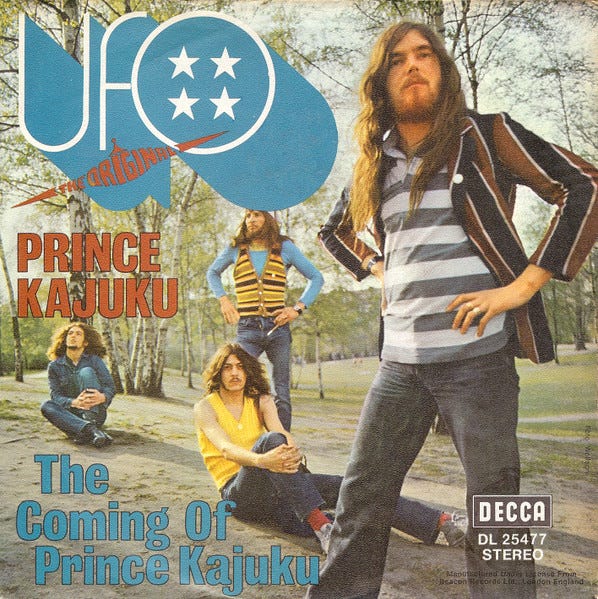
UFO’s second album, however, with Bolton, Flying, was recorded in 1971, and its sound was a far cry from what I had become familiar with. Often referred to as “One Hour Space Rock,” it lives up to its name. The album is filled with extended, psychedelic, and spacey progressive rock tracks. The title piece alone runs for over twenty-six minutes and ends with a backmasked recitation of Rudyard Kipling’s poem “Gunga Din.”
Opening with the brilliant ‘Silver Bird,’ singer Phil Mogg narrates a surreal experience of encountering a UFO, stepping inside, and soaring high into the heavens. It seamlessly segues into the vast, strange soundscape of ‘Star Storm,’ by far the most psychedelic track the band ever recorded. The acid has clearly kicked in, and we are now flying through the cosmos with groovy jams, weird guitar effects, dissonant improvisation, and various quirky guitar bleeps and bloops before returning to the song's primary melody. The side ends with the fuzzed-out ‘Prince Kajuku.’ An interstellar encounter that blends themes of first-contact colonial exploration in the deepest, most remote regions of places like Papua New Guinea, alongside the discovery of extraterrestrial life.
It is, however, the opening song on side two of Flying, ‘The Coming Of Prince Kajuku,’ that remains to this day my absolute favorite UFO track. Bolton’s melodic guitar, Way’s throbbing bass, and Parker’s drums eventually explode like a herd of stampeding horses. The final twenty-five seconds are a whirlwind of intense riffs and Parker’s frenzied drumming that literally blows your head off.
However, with so much music packed into its thirty-minute sides, you really need to crank up the volume—way up!
Unbeknownst to me at the time, UFO’s Flying was probably the first psychedelic album I ever owned. The tracks were lengthy and filled with peculiar sounds, chirping guitar, string-bending whammy, freaky effects, thick riffs, and bizarre lyrics, all propelled by Andy Parker’s drumming that seemed to elevate Bolton’s acid-infused guitar jams. Little did I realize I would be all in on psychedelia, three years later at sixteen, scouring record bins in search of acid rock treasures from the 1960’s. An obsession that lasted three decades, was likely ignited by UFO’s Flying, sparking my love for psychedelic rock.
These days, I don’t listen to much music from my pre-16 youth years, but I will always be a fan of UFO. Their records still hold a special place on my shelves and receive regular spins on my turntable. I also firmly believe UFO is one of the most criminally overlooked and underrated rock bands of the 1970s, and the brilliance of Strangers In The Night serves as the perfect example of my argument.
Turn it up to eleven! 🤘
Happy New Year & Thank You for being here with me!
A version of American football played in yards and streets where one person, often an older kid, plays quarterback for both teams.
These two tracks didn’t appear on the 1978 setlist. They were recorded at The Record Plant, Los Angeles, in November 1978, and added to the album with fake crowd noise. As Schenker left in late October, guitarist Paul Chapman was asked to record these two tracks. There are also unverified rumors Chapman was overdubbed on some of Schenker’s guitar parts. This no doubt contributed to Schenker's dissatisfaction with the completed record. Amazingly, despite not featuring Schenker, they are the finest, most electrifying versions of ‘Mother Mary’ & ‘This Kid’s’ on any official UFO release and are absolutely essential!
Slash (Guns N’ Roses) and Kirk Hammett (Metallica) have both cited Strangers In The Night as a huge influence on their guitar playing.
1982 UK and Ireland reissue on A.K.A Records.


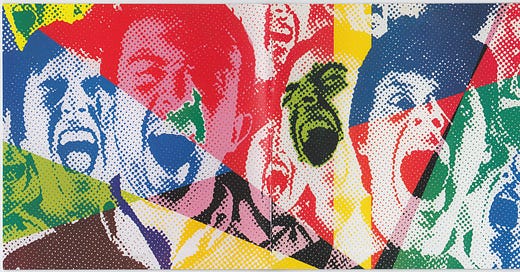


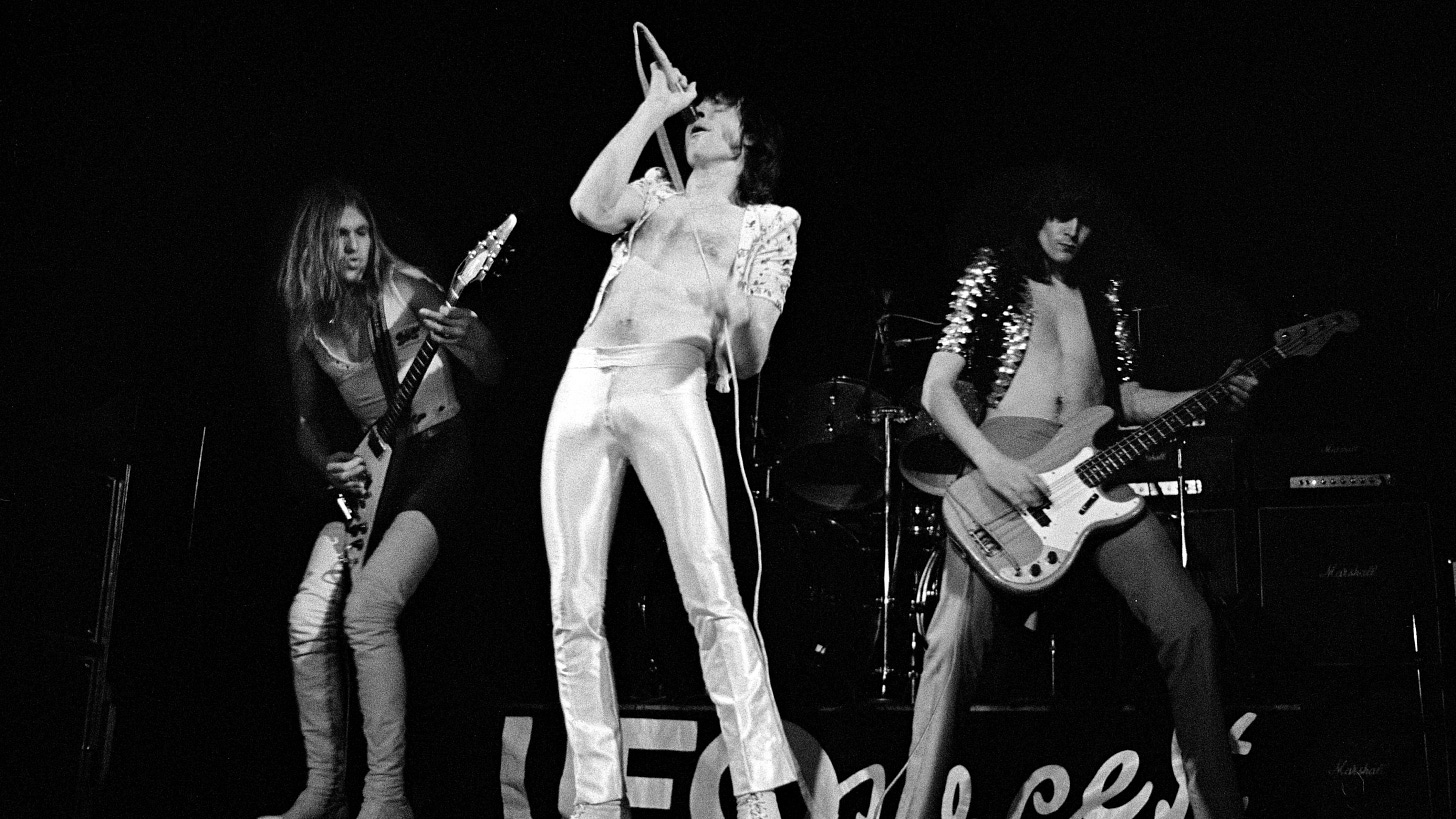
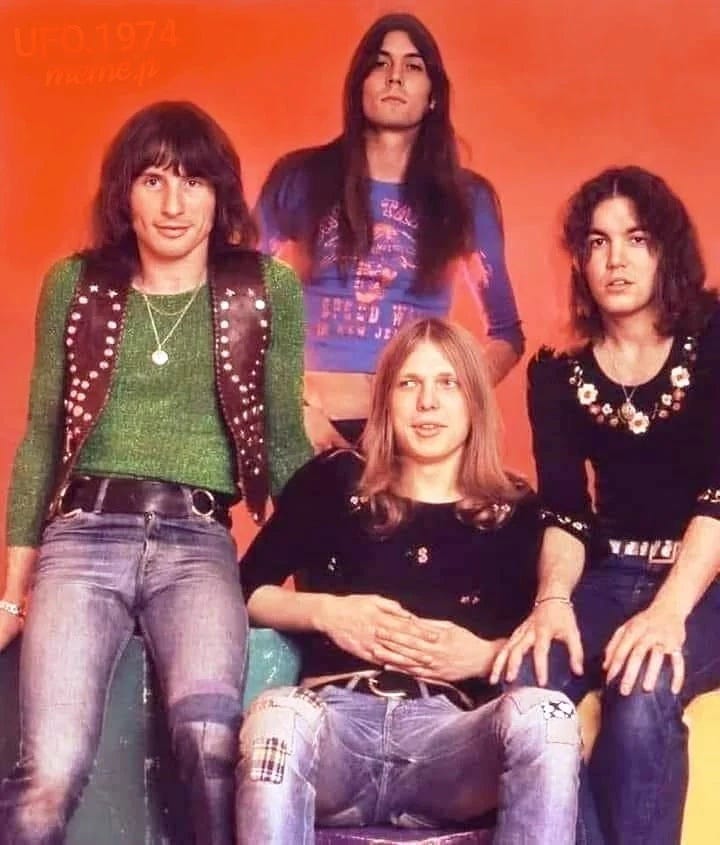
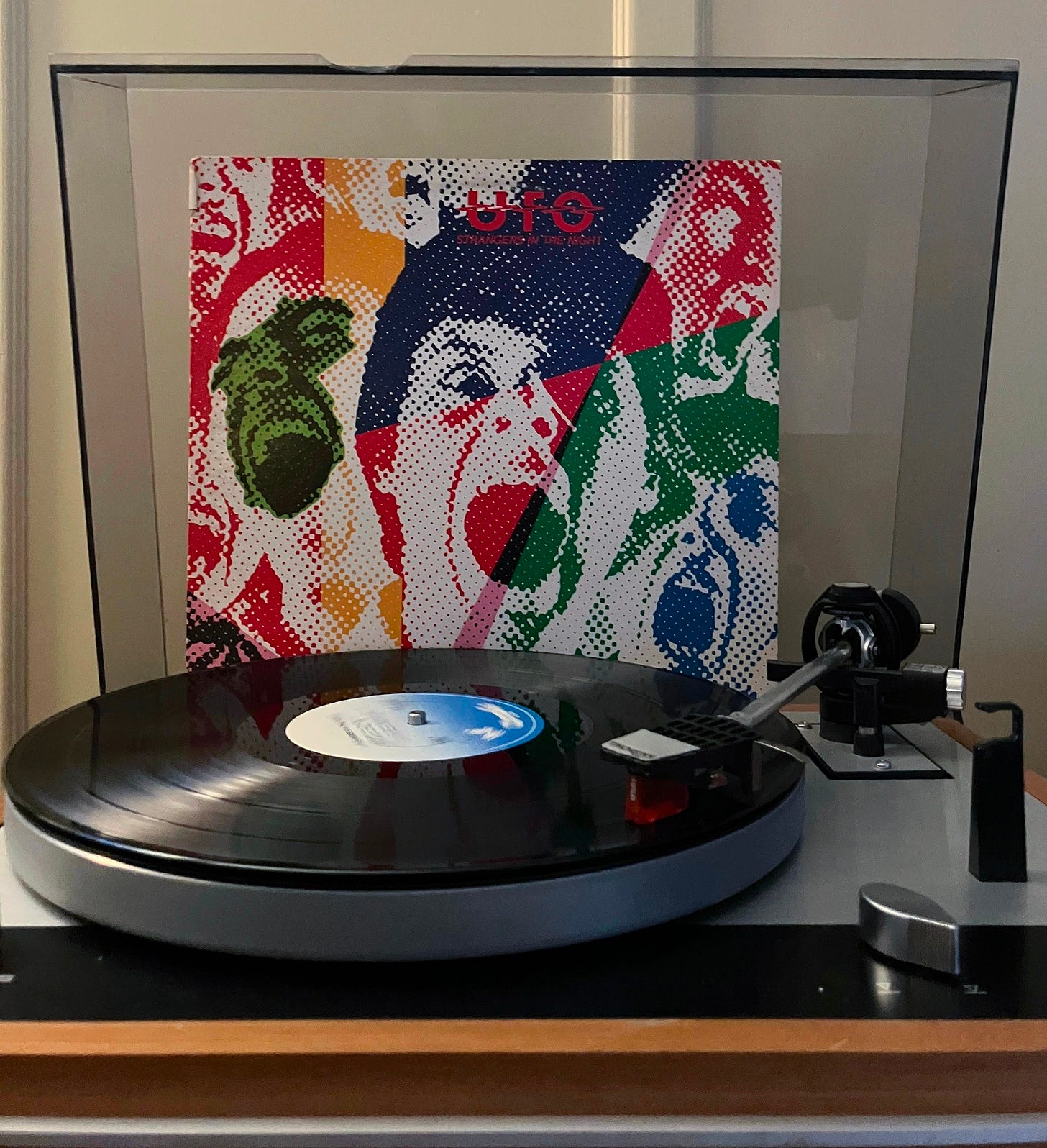
Great post! I got turned on to UFO in early 1980, thanks in part to the cuts from Strangers that WLUP in Chicago played semi-regularly. Like you, I definitely picked up on them coming from a more grown-up perspective; unlike you, I bought only Strangers and Lights Out as a young teen, and didn’t really begin to explore their other albums until a good decade later. These days, I love just about everything they did through 1982 or so…
First time listening to UFO. The Coming of the Prince was my favorite among those you shared here. I didn't really get into music until I hit my teens. Then it was the Beatles, the Stones, Dylan, Joplin, Hendrix, Morrison, Cream and on from there. Now I rarely listen to rock. It's interesting to look back at our musical journey.